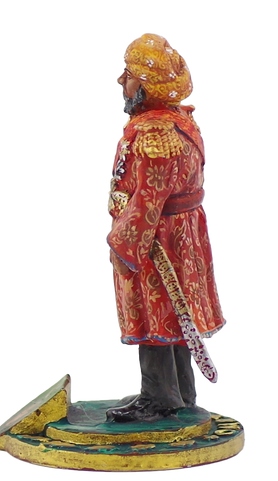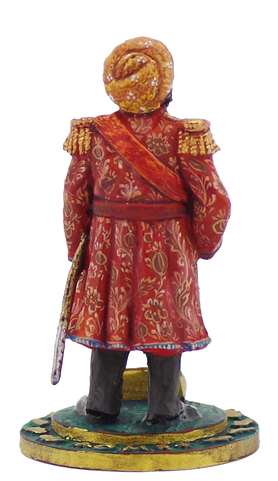
Abd al-Ahad Khan
Emir of Bukhara
Said Abd al-Ahad Khan (26 March 1859 in Karmana – 3 January 1911) was the 7th Emir of the Uzbek Manghit dynasty, the last ruling dynasty of the Emirate of Bukhara, which at the time was a part of the Russian Empire. He ascended to the title aged 26 upon the death of his father, Muzaffar bin Nasrullah, on 12 November 1885. Born in the city of Kermin on March 14 (27), 1859 (according to other sources - in 1857), in the family of the Emir of Bukhara, Sayid Muzaffar Bahadur Khan. According to contemporaries, the emir’s mother, a Persian slave named Shamshat, was distinguished by a rare intelligence and became the beloved wife of Emir Muzaffar. From the age of 14 (according to other sources - from 18) Abdulahad Bahadur Khan was the ruler of the city of Kermine. According to the Russian travelers who visited him, the heir to the emir of the Bukhara Emirate led a rather simple lifestyle. Young Abdulahad Bahadur Khan was a great fan of horse riding and was considered one of the best riders in the emirate. In October 1885, having learned about the death of his father, Abdulahad Bahadur Khan immediately left the city of Kermine and, accompanied by 1000 horsemen, went to Bukhara. Before entering Bukhara, the new emir visited the mazar (place of worship) of Bahauddin, where he performed prayer. On the same day he participated in his father's funeral. On October 31, 1885, in the Bukhara fortress (arch), a ceremony was held to

raise the emir on a felt - a carpet made of camel hair. Abdulahad became the first ruler of Bukhara, whose reign was entirely carried out in close cooperation with the imperial house of the Russian Empire, whose protectorate his father took over in 1868. The emir personally and very actively participated in the astrakhan fur trade, occupying third place in the world market in terms of the volume of trade operations with this valuable fur. According to some reports, a huge amount was kept in the emir’s personal accounts in the Russian State Bank alone - about 27 million rubles in gold, while about 7 million more were kept in private commercial banks in Russia. During his reign, new awards appeared in the Bukhara Emirate - Medals of the Bukhara Emirate. In 1886, he established the Order of the Crown of the State of Bukhara. Abdulahad Bahadur Khan paid great attention to the armed forces of his state. In 1895, he reorganized the Bukhara army. The Emir of Bukhara had the retinue rank of Adjutant General (February 19, 1902), was a cavalry general of the Russian Army (1900), ataman of the Terek Cossack troops, and chief of the 5th Orenburg Cossack Regiment. The emir bore the title "Highness", granted by Emperor Nicholas II in 1896.

The emir's army was of a decorative nature, and although its number reached 10–11 thousand people of various types of weapons, it did not represent a serious military force and had no real significance, causing only unnecessary, burdensome expenses for the population. Sent to Bukhara in 1881, at the request of Emir Muzaffar, Russian officers trained Bukhara military units in the Russian military system, formed new military units and introduced a Russian team. However, the combat effectiveness of the Bukhara army did not increase at all, only the emir’s personal convoy, which consisted of a horse battery, was well armed, had a military bearing and was equipped like the Terek Cossack troops. All other military units, especially in the provinces, were a disorderly crowd in terms of uniforms and training; There were still guns from the late 18th century. or the beginning of the 19th century, loaded from the muzzle. The artillery was the most primitive; the officers, recruited from the lower ranks or from the emir's servants, had no educational qualifications; among the officers there were many illiterate people. In St. Petersburg, for political reasons, the tsar paid flattering attention to the emir's army. At his request, the Emir was given either several thousand rifles or horse-drawn gun batteries with ammunition for his army. The ideas of the Turkestan governor-general to reject the emir’s requests
regarding the release of weapons to him were not taken into account, since the emir, when he was in St. Petersburg, always personally sought from the tsar an appropriate decree both in this and in other matters.

The Manghud, or Manghit, (Uzbek: Mangʻit) were a Mongol tribe of the Urud-Manghud federation. Manghuds (Mangkits or Mangits) who moved to the Desht-i Qipchaq steppe were Turkified. They established the Nogai Horde in the 14th century and the Manghit dynasty to rule the Emirate of Bukhara in 1785. They took the Islamic title of Emir instead of the title of Khan, since they were not descendants of Genghis Khan and rather based their legitimacy as rulers on Islam. The Manghits had been settled by Genghis Khan around the city of Qarshi. Qarshi would continue to serve as the Manghits' base of power under the Bukhara Khanate. In the 18th century, the basins of the Amu Darya and Syr Darya passed under the control of three Uzbek khanates, claiming legitimacy in their descent from Genghis Khan. These were, from west to east, the Qunggirats based on Khiva in Khwarezm (1717–1920), the Mangits in Bukhara (1753–1920), and the Mings in Kokand (Quqon; c. 1710–1876). The Manghit dynasty was founded by a common Uzbek family that ruled the Emirate of Bukhara from 1785 to 1920. Manghit power in the Khanate of Bukhara began to grow in the early 18th century, due to the
emirs position as ataliq to the khan. The family effectively came to power after Nader Shah's death in 1747, and the assassination of the ruling Abu al-Fayz Khan and his young son Abdalmumin by the ataliq Muhammad Rahim Bi. From 1747 to the 1780s, the Mangits ruled behind the scenes, until the emir Shah Murad declared himself the open ruler, establishing the Emirate of Bukhara. The last emir of the dynasty, Mohammed Alim Khan, was ousted by the Soviet Red Army in September 1920, and fled to Afghanistan. There is disagreement over whether the dynasty descends from simple Uzbeks or of true Mongolian origin. According to the Russian orientalist N.V. Khanykova, the Mangit dynasty was considered the oldest Uzbek family in the Bukhara Khanate descending from Timur Malik; from the division of which the tuk came the reigning dynasty, in addition, this clan enjoyed some special privileges.
Awards: Insignia, sash and star of the Order of the Crown of the State of Bukhara, Stars of the Order of Noble Bukhara, the Order of Iskander-Salis, the Imperial Order of Saint Prince Vladimir, the Imperial Order of Saint Alexander Nevsky and the Imperial Order of the White Eagle.






